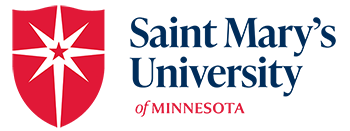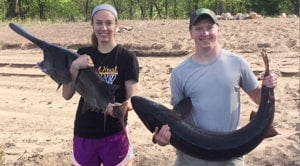Saint Mary's Newsroom
Campus ConnectionAn update from the president to alumni and parents
Athletes, alums honored at Cardinal ‘M’ Club Weekend
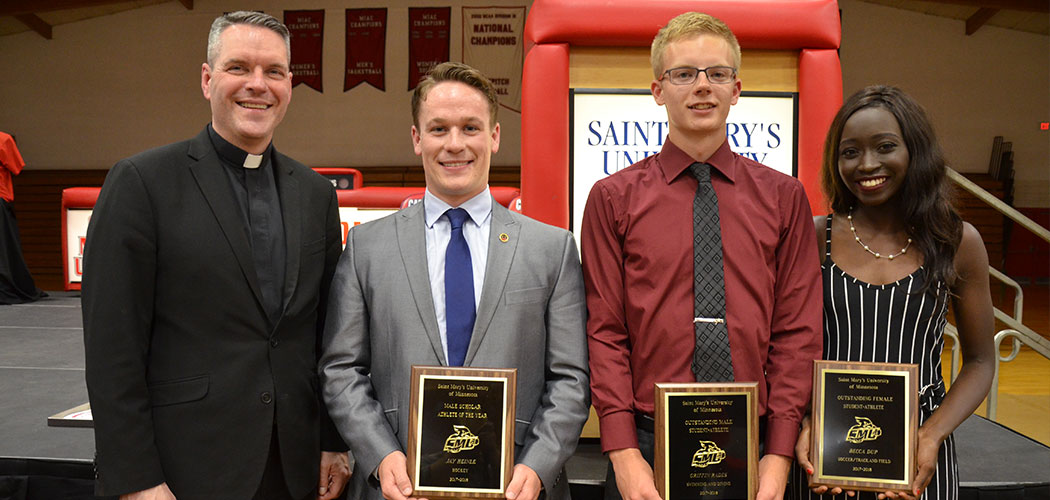
From left, Father James Burns, Saint Mary’s president; Jay Heinle, Outstanding Male Scholar Athlete; Griffin Rades, Outstanding Male Athlete; and Becca Dup, Outstanding Female Athlete. Not pictured: Emily Loof, Outstanding Female Scholar Athlete.
The annual Cardinal ‘M’ Club Weekend has proven to be a great way to look at the past, present, and future of Cardinal athletics. On Friday, the university honored student-athletes and alumni for their accomplishments in competition and in the classroom during the Sports Hall of Fame and Awards Ceremony. Receiving Outstanding Male and Female Athlete awards were Griffin Rades (men’s swimming and diving) and Becca Dup (soccer, track and field). Jay Heinle (men’s hockey) and Emily Loof (women’s soccer) were honored as Outstanding Male and Female Scholar Athletes. In addition, two new members were inducted into the Saint Mary’s Sports Hall of Fame. The Cardinal ‘M’ Club, in association with the Saint Mary’s Alumni Office, welcomed Roger Pytlewski ’66 (men’s basketball) and Angie Wright ’00 (fastpitch softball). The weekend also featured a golf outing, alumni games, and varsity athletic contents. Check out the photo gallery from the ‘M’ Club ceremony.
Exploring our Lasallian mission
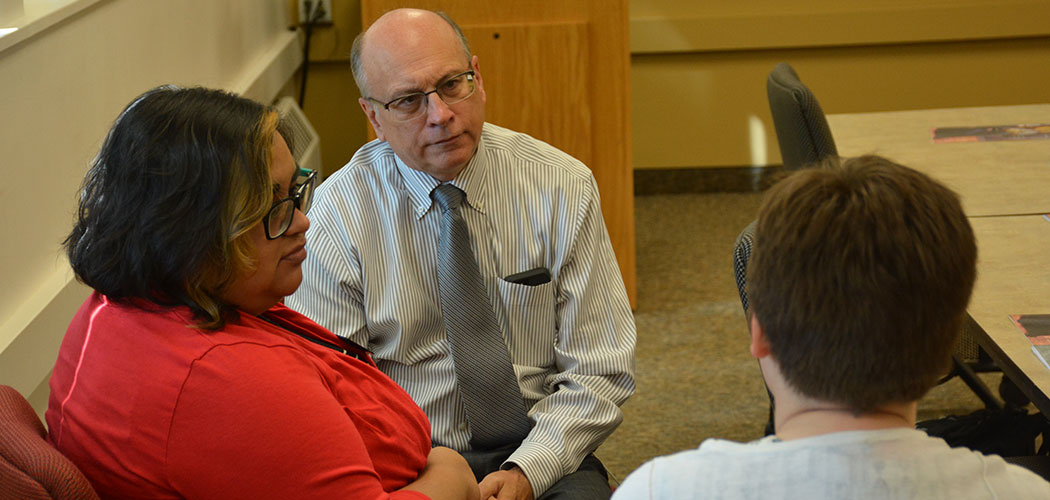
Participants engage in discussion during Lasallian Mission Days on the Saint Mary’s Twin Cities Campus.
This week, Saint Mary’s welcomed 10 participants to its Lasallian Mission Days, a formation program that provides an opportunity to learn more about many aspects of our Lasallian mission. Participants met for four hours each day on the Twin Cities Campus from Sept. 10-13 to discuss topics such as the life and times of Saint John Baptist de La Salle, the development of the international Lasallian educational mission, service to the poor, Lasallian spirituality, the De La Salle Christian Brothers worldwide and at Saint Mary’s, as well as the history of Saint Mary’s. Various colleagues from the Schools of Graduate and Professional Programs also gave presentations. The program is particularly geared toward new members of the university community as well as those who would like to know more about our Lasallian mission today. Find more information about Mission Education and Formation Opportunities.

RSVP for presidential inauguration
You’re invited to the inauguration of Father James P. Burns on Friday, Oct. 5.
Come be part of history as we recognize our 14th president, Father James P. Burns, during a very special day to remember. As we showcase our campus, network and connect with leaders in business, government, and education. Enjoy a special community luncheon and sample a variety of tasty hors d’oeuvres during the reception.
Watch for more details of how to get involved and for special student events tied to the celebration weekend including:
- Service opportunities on campus.
- A Saturday afternoon soccer tailgate party with games, inflatables, and giveaways.
- A Saturday artisan fair on the plaza with music, food and artisan vendors, farmer’s market tables and more, sponsored by the Kabara Institute for Entrepreneurial Studies.
- Additional photo shoots for the “I am Saint Mary’s” photo display.
Oct. 5 inauguration schedule
10:15 to 11:30 a.m. — Inauguration Mass
Saint Thomas More Chapel
11:45 to 1 p.m. — Lunch
Gostomski Fieldhouse
This is a community lunch for our faculty, staff, and students.
2 to 4 p.m. — Inauguration Convocation
Gymnasium, Toner Student Center
The choir and concert band will perform; students will display the flags of their native countries; flowers and displays will decorate the campus.
4 to 5 p.m. — Inauguration Reception
Gostomski Fieldhouse
For more information, go to smumn.edu/inauguration.
RSVP
Students RSVP here: mysmumn.org/inaugurationstudent
Faculty RSVP here: mysmumn.org/inaugurationfaculty
Staff RSVP here: mysmumn.org/inaugurationstaff
Alumna returns to give presentation on career in public health
Saint Mary’s alumna Dr. Holly Schuh ’08 is on campus today, Friday, Sept. 14, to give a presentation titled “Painting, Piano, People, and Public Health: exploring career pathways with intentionality and adaptability” at 2:30 p.m. in the Science and Learning Center auditorium. All are in invited to attend.
Dr. Schuh completed an individualized major in visual arts with a concentration in business, plus minors in biology and music, here at Saint Mary’s in 2008. Since then, she completed a Masters in Public Health at Loma Linda University, and a Ph.D. in International Health and Health Systems at Johns Hopkins University. She will trace and detail the career pathway that has allowed her to travel around the world studying complex adaptive systems and the factors that can change their behavior as they relate to public health.
Saint Mary’s hosts Winona Water Day on Sept. 22
Sustain Winona and the Izaak Walton League of America have partnered together to put on the very first Winona Water Day, Saturday, Sept. 22, from 11 a.m. to 3 p.m. All are invited to this free event where participants can learn all about the ways we are connected to water and the variety of ways to help protect it.
Transportation will be provided. Vans will circle between Levee Park, Saint Mary’s University, and Gilmore Creek. Attendees can learn about water quality and Winona’s conservation history during short educational presentations at Saint Mary’s University. Join in the fun at Gilmore Creek by jumping in or spending time with the Izaak Walton League for stream monitoring demonstrations. Levee Park will feature a variety of organizations including Whitewater State Park and their LEGO watershed model, Winona County Soil and Water Conservation District, Healthy Lake Winona, Izaak Walton League – Upper Mississippi River Initiative, the City of Winona, National Trout Center, Water Bar & Public Studio, and much, much more!
Contact sustainwinona@gmail.com if you have questions.
Upcoming presentation on Adverse Childhood Experiences
 Students, faculty, and staff are invited to attend a presentation on Adverse Childhood Experiences on Wednesday, Sept. 26, at 7 p.m. in the Science and Learning Center. Presenter Victor Vieth is the founder of and a consultant with the Gundersen National Child Protection Training Center; president of the Academy on Violence & Abuse; and director of education and research at the Zero Abuse Project. He will give an overview of research regarding Adverse Childhood Experiences and provide concrete suggestions for recognizing and responding to trauma.
Students, faculty, and staff are invited to attend a presentation on Adverse Childhood Experiences on Wednesday, Sept. 26, at 7 p.m. in the Science and Learning Center. Presenter Victor Vieth is the founder of and a consultant with the Gundersen National Child Protection Training Center; president of the Academy on Violence & Abuse; and director of education and research at the Zero Abuse Project. He will give an overview of research regarding Adverse Childhood Experiences and provide concrete suggestions for recognizing and responding to trauma.
This event is being sponsored by Hope Harbor and Saint Mary’s University’s School of Education. Free will donations will be accepted to benefit Hope Harbor.
Prayers for the Dieterman family
Dr. Larry Dieterman passed away peacefully at his home in Winona on Sept. 12. A wake/visitation is planned for Friday, Sept. 21, from 5:30 to 8 p.m. at Fawcett Junker Funeral Home and a funeral Mass will be held 10:30 a.m. Saturday, Sept. 22, at St. Mary’s Parish.
Dr. Dieterman taught in the Chemistry Department at Saint Mary’s from 1963-1999. His wife, the late Shirley Dieterman, was the daughter of former baseball coach, Max Molock. Shirley preceded Larry in death and worked as a lab tech in the Chemistry Department at Saint Mary’s from 1989-2004. The couple has many ties to Saint Mary’s. Survivors with ties to Saint Mary’s include sons Daniel Dieterman ’83, Douglas Dieterman ’92 and Scott Dieterman ’84; two grandchildren, Felicia Dieterman ’15 (daughter of Doug), and Tyler Dieterman ’08 (son of Scott); and a daughter-in-law Eve (Kendrick) Dieterman ’85, (spouse of Dan).
His obituary can be found here. Saint Mary’s extends its sympathy to the Dieterman family.
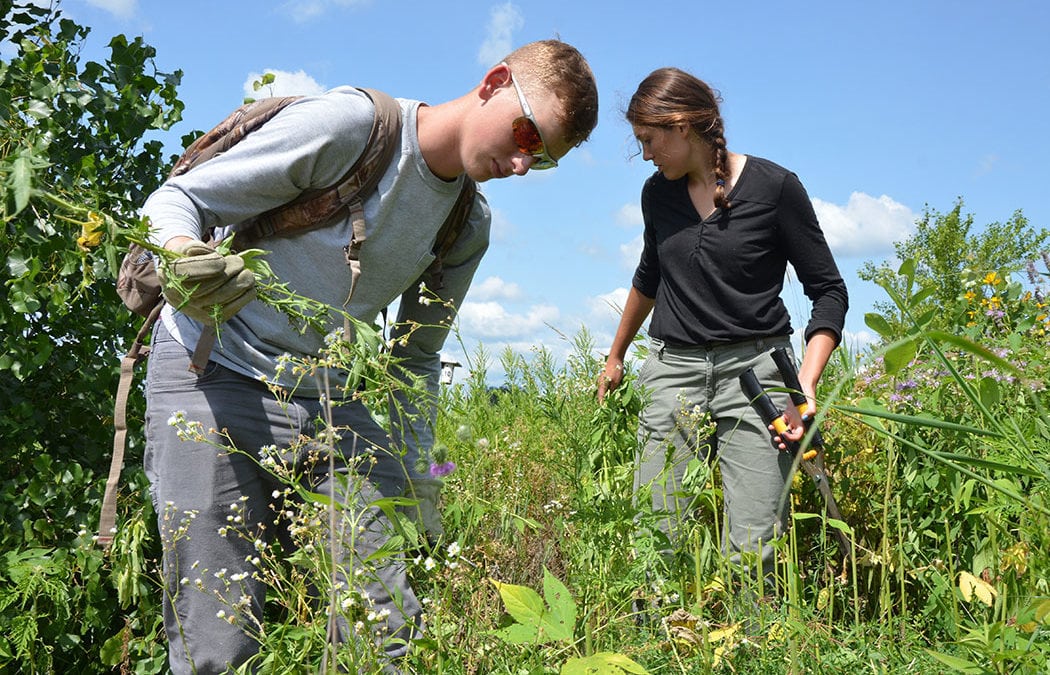
Outdoor learning on a new level
Saint Mary’s University science interns spent the summer researching area bat habitats, testing local waters, and removing invasive species.
Not only did they gain valuable research techniques and knowledge (like how to distinguish the call of a brown bat from a red bat, how to avoid wild parsnip, and what effects nutrient pollution has on water quality), they also learned how their work can contribute to helping issues on local, regional, and even potentially national levels.
Bat research
Dr. Ben Pauli and Ben Borash ’20, an environmental biology major from Bowlus, Minn., are hoping their contributions can eventually help end a bat epidemic.
“The reason why studying bats is so important is that bats are at this conservation crisis crossroads,” Dr. Pauli said. “They’re suffering from white-nose syndrome, a fungus that infects them during hibernation. It started in New York state 12 years ago and is moving westward. It’s only been in Minnesota a couple of years.”
Dr. Pauli explained that the syndrome causes bats to wake up too much during hibernation, which causes them to burn too much reserve energy for them to be able to survive.
“When a cave gets infected with this disease, 95 percent die. Over the past 12 years, we’re talking 7 million dead bats in U.S. It’s a crisis,” he said. “Because each female typically only has one pup, populations don’t bounce back quickly.”
Their ongoing research goal is to make sure bats have the best circumstances possible when they come out of hibernation, beginning with studying their summer habitats.
As part of his 400-hour internship, Borash recorded bat calls with special equipment he attached to the top of a van. Slowly traveling about 30 miles a night, Borash covered several routes and eight survey sites. “We started our routes a half hour after sunset,” he said. “If it was raining or windy, we couldn’t do it because bats won’t come out in these conditions.
“Studying bats was never something I had thought of doing before, especially echolocation monitoring,” he added. “Now I definitely have a heightened appreciation for them. There are seven species of bats just in this area.”
Bats, Dr. Pauli said, are constantly making noise and sending out signals, but because their calls are so high pitched, humans can’t hear them.
“I had no idea that each species of bat has a very distinct call,” Borash said. “We can identify them solely based on their calls. Also, we can determine where they are living. They like to live in trees, but they also like the open spaces because that’s where the bugs are. That’s where we tended to get more calls.”
At this point Borash said he can only pick out a couple of species’ calls, but he’ll be working more on that in coming weeks as listens to the recorded calls. Then he’ll use Geographic Information System-related software to calculate which environmental factors are important to the bats’ habitat.
“What about the landscape attracts bats to those spots? Is it wooded, near water, near agriculture? He’ll identify the features of the environment,” Dr. Pauli said. “Then we can start answering questions about what bats like. And then we can apply that knowledge to the conservation crisis.”
In addition to his own research, Borash also contributed to a statewide DNR bat monitoring program in Wisconsin.
“It’s almost humbling knowing that this could have an impact, no matter how small,” Borash said. “Especially since it’s not something we know a lot about at this point, we’re on the front line of that research.”
Borash, who hopes one day to get a job as a park ranger, appreciates the opportunity to work outdoors, do cutting edge research on bat habitat selection, and work so closely with one of his professors. “It’s a lot different seeing professors in a classroom, as opposed to out doing research,” he said. “Oftentimes this is why they got into teaching, because they live for this research. It’s great to see how passionate they are about their work.”
Water quality research
Josh Balsiger ’20 and Michele Remer ’20, both environmental biology majors, spent the majority of their summers on boats or in the lab as they studied the health of the watershed around Lake Winona.
The students, led by Dr. Josh Lallaman, went to nine sites around Winona and its watershed to take dissolved oxygen and temperature measurements and to collect water samples, which they analyzed in the lab for nutrients, phosphates and nitrogen levels, conductivity, pH levels and chlorophyll.
“This data is going directly to the county, which is going to use data to make decisions about how to manage and improve water quality in Lake Winona,” Dr. Lallaman said. “So it’s a great opportunity for students to collect real data and a good collaborative building experience between the university and local government.”
At issue, he said, is the fact that Lake Winona is too green, a result of algae that is a direct result of having elevated amounts of nutrients, nitrogen, and phosphorous that are coming in from locations like Gilmore Creek. “From our preliminary results, we’ve confirmed previous studies that say Gilmore Creek contributes some of those nutrients. Some still comes out of Boller Lake and enters Lake Winona. It’s still coming from lots of different places. It’s good preliminary data to address this problem.”
“It’s cool that we are helping inform decisions that need to be made at a policy level and a personal level in order to take the watershed to a new area,” said Balsiger, a Camas, Wash., native.
Balsiger said increased phosphorus allows for more plant growth and this increase comes from both agricultural runoff from pesticides, as well as urban runoff. “Storm sewers don’t have drainage systems, and that leads to an abundance of algae in Lake Winona,” he said.
The students also completed a soil workshop with Dr. Lallaman where area farmers learned about soil health and how to analyze soil samples, and they also assisted Dr. Lallaman with other research by weighing and tagging sturgeon, paddlefish, and carp on the Mississippi.
“This summer internship is a great experience to get to know students better, get to know what their career interests are, get to know them on a personal level, and work on their strengths and weaknesses,” Dr. Lallaman said. “We can make helpful suggestions on further career development while they are here or after they leave Saint Mary’s.”
Both Balsiger and Remer know they’d like to continue working in science research. Remer would like to work outside of the U.S.; Balsiger wants to eventually get his master’s degree.
“We’re getting field experience and that’s something that not a lot of undergraduates get to have,” Remer said. “We’re also working one-on-one with professors. We get to know them pretty well and help build relationships,” the Grand Forks, N.D., native added.
These students know that getting letters of recommendation from professors who know them well and know their capabilities is invaluable. And the time they’ve spent learning proper lab techniques will help them throughout their educational journey and beyond.
“We talk about that we would do this every summer if we could,” Balsiger added. “Next summer, some new lucky person gets to learn all the things we learned. We spend half the time exploring the world and half the time feel like a scientist doing these amazing things.”
Prairie restoration
Erin Hettinger ’20 and Cole Van Houten ’21, both environmental biology majors, spent the majority of their summer internships at Saint Mary’s Cascade Meadow facility in Rochester, where they learned about plant identification and helped with invasive species management and other prairie restoration efforts.
“We go around cutting and pulling species that shouldn’t be there,” Hettinger said. “I like the idea of conservation in general, so this was a great experience. There is so much work that goes into restoration, the planning, and seeing what techniques work and what doesn’t.”
The Lindenhurst, Ill., native hopes to go to grad school but is not sure what area she wants to pursue. “I love environmental biology, and I love being outside but wasn’t sure about career options,” she said. “I liked the idea of restoration and this was a perfect way to get my foot in the door to see if it’s something I’m interested in.”
Earlier in the year garlic mustard was a primary target; later in summer they focused on eliminating wild parsnip. “If you touch it, it burns your skin,” Hettinger said. “Because it tends to grow right along the trails, it’s not good if visitors get exposed to that.”
The two are collecting data on where parsnip is located and determined there was no correlation between density and the height of the plants. Their goal is to build a model to predict in the future locations that the invasive species will flourish. “So we can predict where to put management efforts in the future,” Hettinger said.
Van Houten of Pine Island, Minn., enjoys being outdoors, so he knew the summer internship would be a great experience, as well as a resume builder. He hopes one day to study wildlife biology, particularly mountain lions.
“Cascade Meadow was formerly farm land so we’re helping bring it back to its native prairie by taking out invasive plants like parsnip, and garlic mustard, and other various invasives,” he said. It’s nice to see how Saint Mary’s is using that property and taking care of it. It felt nice to be part of something, to better the land stewards there and keep it a prairie.”
As part of their summer research, the two also had an opportunity to do water sampling on the lake at Cascade Meadow with Dr. Lallaman.
“There’s nothing quite like being able to experience a whole growth season for a plant community,” said Dr. Moni Berg-Binder. “That’s really key for those students interested in this area, to get them connected to the land in a different way than before.
“With our entire internship program, the idea is that our students are able to gain hands-on, in-the-field experience that supplements what they gain in the classroom,” she added. What they can gain from the internship experience is they are not just learning about management of some of these species, they’re actually out there managing the invasive species and getting the real-world experience.”
In the beginning, she said, students are mentored, but as the summer progresses, they gain more independence. She said she and Kathy Kilkus Allen from GeoSpatial Services are able to back off intentionally so students “gain that ability to problem solve independently and work through different scenarios on their own, knowing that we’re a phone call away if they need us.”
Work at Cascade Meadow integrates research in invasion ecology with restoration management. By focusing on wild parsnip, she said, they can learn about target management and see the value of their research in an applied way.
On a personal level, Dr. Berg-Binder said, summer science internships is in keeping with Saint Mary’s Lasallian mission. “Part of our Lasallian heritage is to be kind of that big brother or big sister role model,” she said. “Students can see how we balance work and life. That’s important for those who are looking at career paths like we’ve chosen.”
All the students had opportunities to crisscross in their research, getting a taste of all three research areas. And, in November, each student will be making poster presentations at conferences.
“With all of our internships, the goal is to produce an outcome that they can share in some way — to take research a little further,” Dr. Berg-Binder said.
Photo caption: Cole Van Houten ’21 and Erin Hettinger ’20 helped with invasive species management and other prairie restoration efforts at Saint Mary’s Cascade Meadow facility in Rochester, Minn.
Saint Mary’s students to stage ‘Proof’ Sept. 26-30
WINONA, Minn. — Saint Mary’s University of Minnesota Department of Theatre and Dance will present the poignant drama Proof, Wednesday through Sunday, Sept. 26-30, in the Studio Theatre of the university’s Performance Center.
Proof, written by David Auburn and directed by Jimmy Bickerstaff, is the intelligent, witty, and compassionate story of Catherine on the weekend of her 25th birthday, following the death of her famous mathematician father. Set on the back porch of her father’s Hyde Park, Chicago house, the plans of her returning New York sister and a sudden romance with one of her father’s former grad students lead to a mysterious notebook and the most difficult problem of all: Has she inherited her father’s genius — or his madness?
With its remarkable portrayal of the nature of genius, power of love, and value of trust, Proof was awarded the 2001 Pulitzer Prize for Drama and the Tony Award for Best Play.
Watch the simple and elegant story unfold. Showtimes are 7:30 p.m. Wednesday through Saturday, Sept. 26-29; and 3 p.m. Sunday, Sept. 30.
Tickets are $10 for adults, $5 for students and seniors and are available by calling the Performance Center box office at 507-457-1715 from noon to 6 p.m. weekdays or online at pagetheatre.org.
